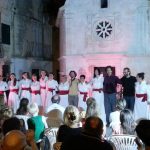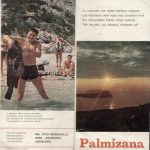“Hvar has reached the bottom of the bottom, and it used to have its audience and was full. Did the audience have to be chased away for the wild youth which don’t even see the town?” asks prominent art collector Dagmar Meneghello.
“In 1965, I came from Zagreb, a city abundant with culture, to an island where nothing was happening, to the complete isolation.” That is how the life story of the legendary Dagmar Meneghello begins, an art collector, a patron of numerous artists and the symbol of the islet of St. Clement which is located across the town of Hvar. Over the past few months, Dagmar has begun to exhibit her collection in neighbouring countries as well, reports Večernji List on August 16, 2018.
Why did you decide to present the collection in the neighbouring countries?
The collection deserves it and there is also a jubilee, half a century of my efforts for the presentation of Croatian art in the world. In Novi Sad, they made available for me the Gallery of Visual Arts and the Museum of Contemporary Art of Vojvodina. The exhibition was supported by the Croatian Civic Alliance in Serbia. It was impressive and had a great impact in the media. The cultural institutions of our country did not respond to my attempts to inform them about the project, they completely ignored it. There were no funds to print the exhibition catalogue either. I exhibited 400 works of great authors: Šebalj, Kulmer, Seder, Lesiak, Šutej, Nives K.K., Jerman, all the people from the 1980s, Vera Fischer and Paulina Jazvić.
But you did have an exhibition last year at Klovićevi Dvori in Zagreb?
I was shocked when I received a call from Martina Bienenfeld from the Zagreb Tourist Board, who told me I could have an exhibition at Klovićevi Dvori. I was told that they appreciate my work as a citizen of Zagreb who believes that the culture of the city should be promoted. Although the exhibition was organised in a smaller space on the ground floor, I presented several works from about a dozen painters. There were many visitors, and that gave me additional satisfaction.
And how was it in Sarajevo?
Just like in Novi Sad, but more impressive and bigger, on 1,200 square metres in the Collegium Artisticum. The Association of Visual Artists of Bosnia and Herzegovina invited me at the suggestion of the graphic artist and painter Amra Zulfikarpašić. They also organised an official opening with important people from the government and a nice catalogue. No one from our embassy came to the opening, although they were the patrons. I often had exhibitions of our artists abroad, but something like this never happened to me. I was ashamed in front of the hosts. I sent the catalogue to our culture minister, but there was no response.
A few days ago you opened an exhibition in the town of Hvar?
I inaugurated the Arsenal Gallery with the Palmižana Collection 35 years ago. A group of Hvar art enthusiasts managed to persuade the town to open an exhibition space in the lobby of the old theatre. The curator of the exhibition was Kruno Prijatelj, the patron of our artistic endeavours at Palmižana. I also exhibited there in 2003, on the occasion of the centenary of the Palmižana tourism. We published a gorgeous monograph on Palmižana, in which I mixed the natural beauty of our sea landscapes with the reproductions of works of top Croatian painters and sculptors; 2,700 copies of the monograph found their home on all continents. The artists and I did everything for free, and Pervan gave me a generous gift – 500 photos of Palmižana. For twelve years, the gallery stood closed, and the theatre is still closed. And the culture has withdrawn when it met the rampage of the Yacht Week and the drugged youth.
How did the Arsenal exhibition come about?
With the celebrations of the 150th anniversary of tourism in Hvar, they opened the venue and proposed a presentation of my collection. I forgot how small the venue was, not even 200 square metres. And the Palmižana collection has been continually growing over half a century. It was necessary to drastically cut it down, and numerous landscape paintings remained closed in the storage. We received help from painter Ivo Čorković. He made a miracle transforming his large installations into coverings and curtains and thus creating a magical space in which we incorporated paintings from 1947 to 1965.
How many works does your collection contain?
About 1,500 works. During a half of the century, hundreds of artists have created and exhibited on Hvar, and visitors were able to enjoy new, current exhibitions. Palmižana was often the first contact for foreign visitors, mostly sailors, with the Croatian culture and art. And the locals also found out about some of the now-famous artists at Palmižana. For fifty years, I have invited the artists to a small island, to a gallery at the end of the world. Palmižana, some 320 hectares of the estate of the Meneghello family, bought around 1800, without water and organized connections with the land, has been transformed into one of the most spectacular arboretums of exotic plants, cacti and lush forests in the Mediterranean.
Do you have plans to find a permanent exhibition space for the collection?
The collection was created from the need to survive on a desolate island and it will be left to the heirs as such, with the desire to preserve and further develop it. I hope my heirs will find a way to permanently exhibit part of the collection if the Croatian society does not show interest. I would like for it to stay on the island. The truly valuable collections are created by generations of collectors.
Over the years, you have been collecting works mainly by modern artists.
Collecting is a re-examination of yourself, your attitude, choice, almost an adventure. To take an encyclopaedia and select already well-known authors required just financial resources. Of course, the risks are much smaller and the gain is much higher. It also benefits narcissism because it shows the financial power of the buyer. I did not want to be such a collector. Sometimes I ran into a valuable painting of an older painter and liked it, but I had already spent money on a younger artist. In buying artists who died a long time ago, the traders are the ones who earn the most. It is the artists themselves who need the money to live and work.
You are not an islander. How did you so passionately adopt the island way of life?
I came to the island for love. My husband simply said that he could not let something that his family had worked on for generations go to waste. I was afraid of the cruelty of life on this paradise island. People cannot understand what is the difference between enjoying this heaven at the best times and being its guardian, constantly under pressure. One old islander told me during my early years at Palmižana: “When you jump, in the air, there is no more return.”
Do the Croatian state and the local Hvar community show any understanding for your artistic concept of the island tourism?
Certainly, there were hard disappointments when I asked or demanded something. I was ignored even when I was giving things. The media writes often and beautifully about us, but that is like a wind. And so, the criminals and the mafia have been stifling my family for decades and trying to take a bite of our property, which was honestly bought and developed with hard work.
Hvar is celebrating the 150th anniversary of organized tourism. Have we learned anything in these 150 years?
Hvar has reached the bottom of the bottom. You can take a walk in the morning, just make sure you do not stop in the p*ss, excrement, vomit or on sleeping youngsters. On the islands with protected nature, where repairing a wall can be punished, there are hundreds and thousands of drunk and wild young people being brought, looking for nirvana in high decibels and drugs. And they destroy both themselves and all around them. How can someone now stop the avalanche? Many have opened primitive hostels with six or eight beds in a room and make good money. Everything that was neither good nor high-quality is now fine. Hvar had its own audience and was full. Was it necessary for that audience to be chased away for this wild youth? Perhaps they could have been given some deserted bay since they do not see the town and its centuries-old heritage anyway. This question is now unnecessary because it is too late. No one can stop this Sodom and Gomorrah anymore. There is too much money involved, money from people to whom nature and culture do not mean anything. I said at the opening of an exhibition that the Mediterranean is lavish and tinted with colours, figurations, scents, and that Hvar is the heart of the Mediterranean. But, that hear is now terribly ill.
Translated from Večernji List (reported by Denis Derk).











